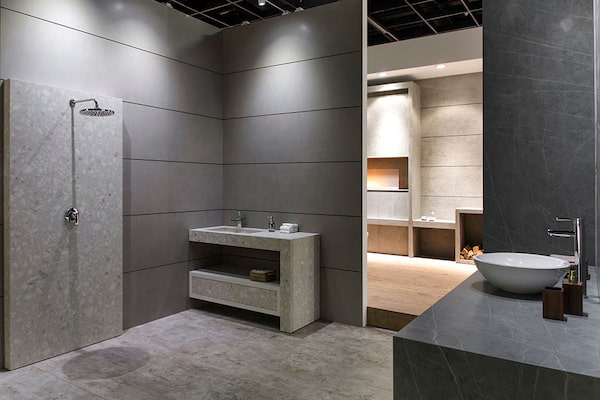
A seamless floor in the bathroom leading to a linear drain is a modern way to use terrazzo in your home.MARBLE TREND
Those Venetians really were on to something 700 years ago, when workers were developing terrazzo – a material made of specks of glass, granite, stone and marble, polished to a fine sheen.
Back then, it was a way of using up smaller fragments and remnants that would have been tossed away. Now it’s trendy material for the modern home, set in cement or polymer mix that contrasts perfectly with a sleek, clean look, and a variety of other home décor styles. Pinterest listed it as one of its Top 100 trends in 2018 – and saves for “terrazzo” were up 316 per cent.
People of a certain vintage might remember it as a flooring in their elementary school (because of its durability and resilience), but terrazzo is now offering a “pop” factor on ceilings, living room walls and kitchen counters.
Glen Peloso, a designer and a speaker at HomeFest (the new, interactive, festival-style home décor event November 2-4 at the International Centre in Mississauga), says terrazzo is a great mix of nostalgia and endless, wonderful design possibilities.
“It gives you the ability to create a bespoke experience,” he says. In his travels, he says he is seeing the most terrazzo in showers and bathrooms, kitchen countertops and backsplashes, feature walls, water features, tabletops, outdoor furniture tops, and decorative items such as vases, bowls and platters.
“I like the ‘fun’ that the colours and shapes offer a room,” he says. “However, the ‘nougat’ look is less appealing to me lately.”
That’s a good point. When does it become tired?
Gabriella Luchetta, who works with Marble Trend, a Toronto company that imports natural, high-quality stones and engineered products, says terrazzo has been the “100 per cent” most asked-about product this year.
“For years, the marble-style look was [and still is] the main trend in the design industry, with everything from natural stone to engineered porcelain and quartz, mostly in neutral colours of whites, greys and blacks,” she says. “I think the terrazzo trend has really caught on because it has given people the opportunity to stray away from the neutral colours and patterns and indulge in the countless colour combinations that terrazzo offers.”
Indeed, anything is possible. Clients of Marble Trend can create custom colours and stone chips to make their own designs. Ms. Luchetta adds that with new technology and innovative design traditional terrazzo has been mimicked to conform with newer marketplace trends, such as eco-friendly surfaces and the popularity of using such engineered surfaces as porcelain, quartz or sintered stone.
Adaptations of traditional terrazzo include: vetrazzo, which is recycled glass surface created with 100-per-cent recycled fragments, such as beer, wine and vodka bottles, condiment jars, oyster shells, traffic lights and windshields; DNA Urbano by Stone Italiana, which, instead of stone chips, uses gravel or street sweeping debris that builds up along pavement edges – all with a cleaner environment in mind; and Retrostone, a colour by Neolith, which is a "sintered stone" created through a manufacturing process that uses extreme high heat to fuse natural aggregate materials into a virtually non-porous, eco-friendly product (scratch and stain proof, heat and fire resistant). Neolith colours are designed with advanced digital printing technology to create an exact replica of natural stone.
A quick glimpse through Pinterest or Instagram offers up many other creative uses of the terrazzo look – even in accessories such as planters, candles, duvets, rugs, coasters, throw pillows and cooking boards.
Cynthia Soda, owner/principal interior designer at Soda Pop Design Inc. in Toronto (and a stage presenter at the Toronto Fall Home Show), sees terrazzo’s new popularity stemming from a piqued interest in floor tiles of different shapes, colours and patterns, as well as a growing interest in adding design elements underfoot.
“From being something people ‘have’ to live with to something people ‘want’ to have is a funny thing with design finishes,” she says.
Concrete, whether that be floors, wall accents or countertops, has been leading the charge for a while now, Ms. Soda adds, and terrazzo has been a, “unique, natural and organic option making its way back to the top.”
With more homeowners looking at eco-friendly options, terrazzo wins points for sustainability because of its reuse of scrapped rock and other materials, she says. It is also highly durable.
Her Top 3 uses of terrazzo in the home? A seamless floor in the bathroom leading to a linear drain, forgiving floors in a well-used space like the kitchen and in an open-concept basement with white walls.
“I can also see this being used on the walls as backsplash, even fireplace surrounds,” Ms. Soda says. “I feel that everything has a place and, if used correctly and not overdone, yes, I’m onboard!”
Advertising feature produced by Globe Content Studio. The Globe’s editorial department was not involved.